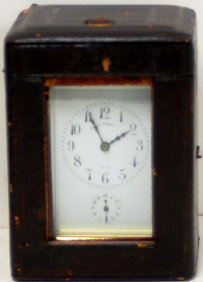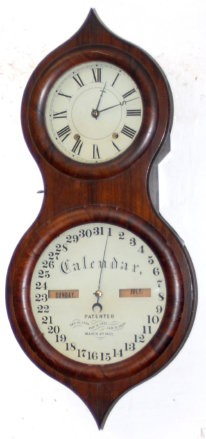

190. $4000
French fire gilded bronze Empire style clock, ca 1810. The female
figure is the personification of astronomy. She is working with typical astronomy instruments. The dial has a star in the center and
the zodiac calendar around the outside of the chapter ring. There are many clocks similar to this one, pictured in the book, “French
Bronze Clocks”, by Elke Niehuser. This clock has an 8-day movement with silk thread suspension and is running and striking a bell.
The movement is signed, “Medaile Dargent / Paris”. Signed behind the wheel winding the silk thread are other words, but I cannot read
them without removing the wheel from the movement. The clock is 26.5 inches high and 20 inches wide. The clock has been appraised
for three times our minimum, but probably for a New York or overseas market. $4500-$6,000.
189. $2500
Ithaca Calendar Clock Co. “No. 3 ½ Parlor-Black Dial”, ca 1881.
The clock has an 8-day spring movement and strikes a nickeled bell each hour. Other nickel accessories include hands, pendulum, and
sashes. The clock case is 20.5 inches high with good original carvings on the top, around both dials, and two large carved ornaments
on each side. There is some silver paint around the side carvings. The clock certainly is not mint for it is very dirty mostly from
being in storage and the upper black dial shows wear. That is an easy fix for they were paper dials originally and you can order replacements.
All the carvings are complete and have no breaks or repairs. The top dial is original and the bottom is silver paint on glass and
it is original. It has the correct glass pendulum bob with the letters, “ICCCo” engraved on the front. This is the two-backboard model
but Bubba managed to glue them together in his home workshop. He also did not like the nails holding the backboard on the case so
he engineered a better way to hold them on. We have sold several of this model over the years and it has always been a very collectable
model bringing $5000 to $6000, if very nice. It needs a good cleaning inside and out, and a new upper dial. Ly Calendar, pages 132-135.
$2750-$3000.
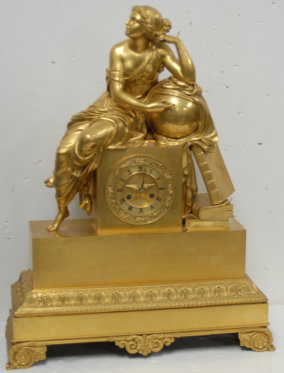
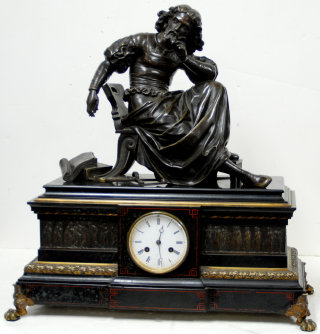
191. $1650
“Tiffany & Co. New York”, signed on the dial of this exceptional
19th century marble and bronze 15-day clock from the Egyptian Revival period, ca 1880. The clock came from the estate of the late
Prussian/German General, Moritz Ferdinand Freiherr von Bissing. Born into a wealthy family he enjoyed the good life of wealth, military
and political titles while adding to the family’s wealth. The clock has no doubt been in several fine collections since his death
in 1917. The last sale of this clock was for $6750. The marble and bronze clock weighs 94 pounds. The base weighs 73 pounds and the
statue of Shakespeare alone weighs 21 pounds. That is more than most tall clocks. The clock is 23 inches high and 22 inches wide.
The statue is signed “T. Hebert”, a famous French sculptor. The case is decorated with rows of female figures each side of the dial.
The statue and clock top are pegged for fitting, so that guarantees the statue and base came together. The sash holds a beveled glass,
it has correct French hands and pendulum, good beveled glass on the back, and a typical round 15 day French movement with nickel bell
attached. The movement is running properly. $1750-$2000.
188. $3000
Seth Thomas “Office Calendar No. 3”, or the Peanut as known
to most clock collectors, ca 1863. A very hard to find model in good original condition. The case is 24 inches tall and covered with
mahogany veneer. Some minor patchwork on the rounded bezels. The case has its original finish, now dark but it suits me the way it
is. The dials have been repainted, the hands are correct, the two glasses are old but have been out of the bezels and put back, probably
when they repaired the veneer. There is a key lock on the case side, and there is a key with it. The movements are original to the
clock. The 8-day time movement is round, has two springs but is time only, and the correct original calendar movement was made by
the Mix Brothers. The movements are functioning correctly, and the other parts, pendulum, keys, etc. are the type we see with this
model. Ly-Seth Thomas, page 92; Ly-Calendar #600. $3300-$3600.

192. $750
French carriage clock that I have owned since I started collecting
clocks in 1970. It has sat in our living room desk, behind glass doors for some 45 years without running. The brass case is like new,
clean and polished. It stands 7 inches high and has five perfect beveled glasses. The porcelain dial has three original hands, a time
ring and an alarm ring. The dial is signed by the selling dealer, “Bigelow Kennard & Co., Boston”. The movement is signed only,
“Made In Paris”. The serial number on the movement and on the original winding key is, “15001”. The movement strikes quarters and
hours, or quarters, or silent. The controls for the sequence is underneath the case. The original carrying case is also signed, “Bigelow
Kennard & Co. Boston”. The movement is running and striking. I sure hate to sell it but a lot of “stuff” has to go away.
$750-$1000.

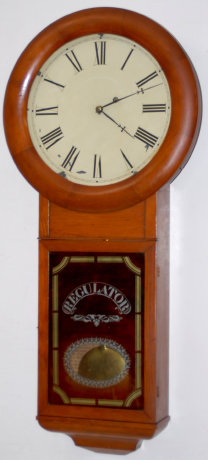
193. $1500
Seth Thomas Clock Co. Plymouth Hollow, Conn. early model of
the “Regulator No. 2”, ca 1863. This clock was made during the time the name “Plymouth Hollow” was being changed to “Thomaston”, to
honor Seth Thomas. I have seen identical clocks with Thomaston labels. This early model does not have a seconds ring and the weight
descends down the middle of the case and behind the weight baffle board. There is a complete paper label and beat scale on the baffle
board. It is unusual to find them both intact, especially in such good condition. The large iron weight, pendulum bob, and wood stick,
are all original for this model. The 8-day brass rectangular movement is not signed, but they rarely are, and it is correct and original
to the case. There is no pulley on the wire. You will note that the movement has a second’s hand post. That means to me that the movement
was one of S. B. Terry’s movements purchased in their 1859 bankruptcy sale. The movement is identical to movements I have seen in
other S. B. Terry regulators and many early Seth Thomas regulators. Another big plus for this 150-year-old clock, is the original
paint on the original dial pan. The only chips are around the screws and the hand arbor, plus a small scratch or two. The 34” high
cherry case is very nice and all original except the backboard. It would fly right on thru most auctions because you can hardly tell.
The clock came from a long-time collector who is beginning to downsize his collection of fine wall regulators. This model has always
sold in the $2000-$3000 range when in good original condition. Ly-Seth Thomas, page 274. $1500-$1750.
